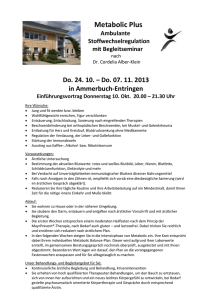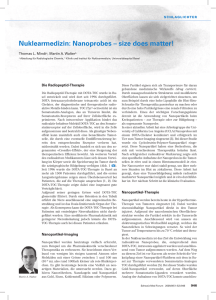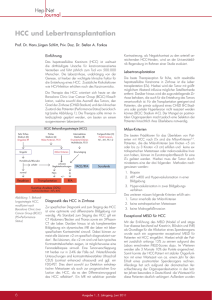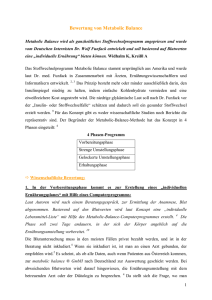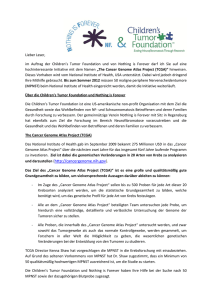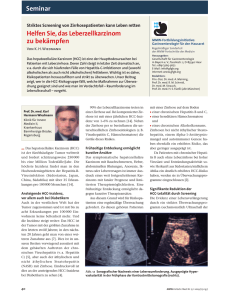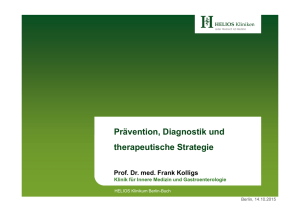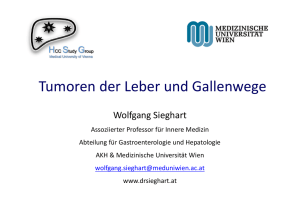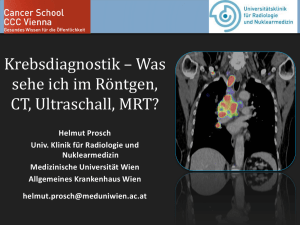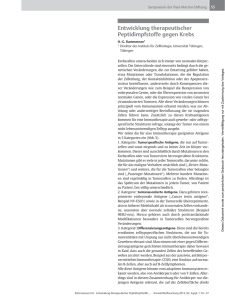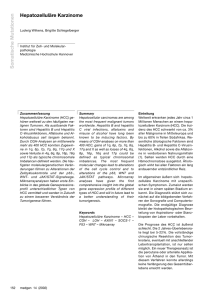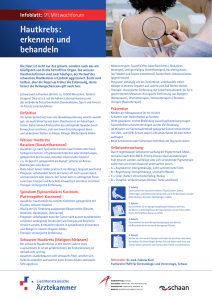hepatomasys - Evaluating cancer`s metabolome for diagnosis and
Werbung
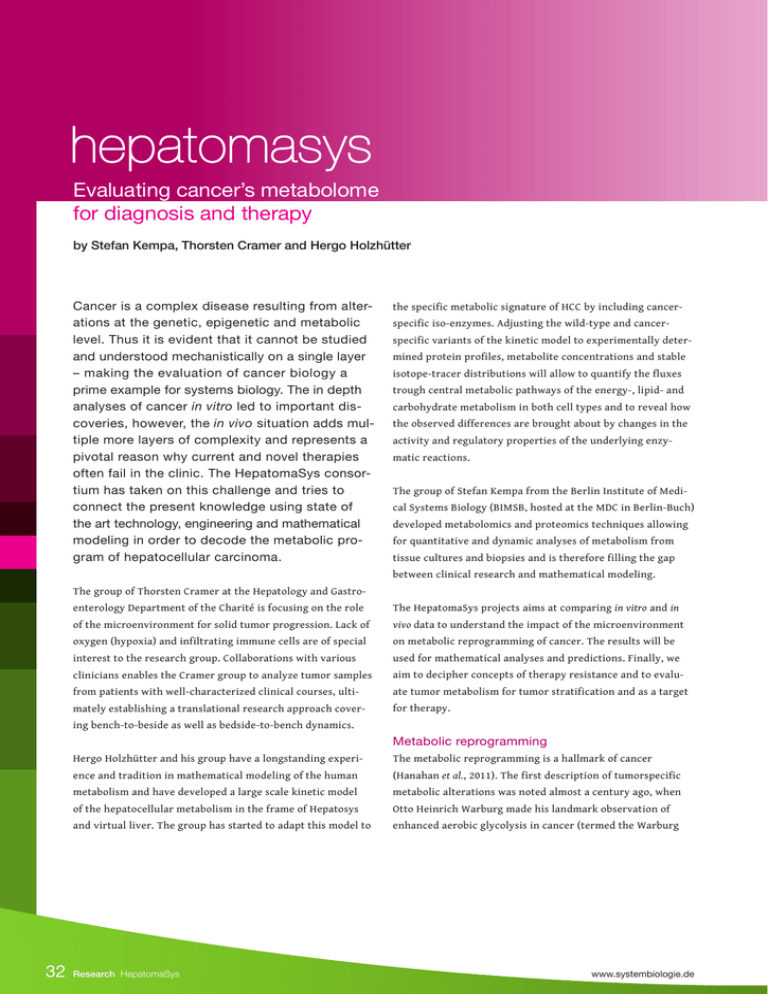
hepatomasys Evaluating cancer’s metabolome for diagnosis and therapy by Stefan Kempa, Thorsten Cramer and Hergo Holzhütter Cancer is a complex disease resulting from alterations at the genetic, epigenetic and metabolic level. Thus it is evident that it cannot be studied and understood mechanistically on a single layer – making the evaluation of cancer biology a prime example for systems biology. The in depth analyses of cancer in vitro led to important discoveries, however, the in vivo situation adds multiple more layers of complexity and represents a pivotal reason why current and novel therapies often fail in the clinic. The HepatomaSys consortium has taken on this challenge and tries to connect the present knowledge using state of the art technology, engineering and mathematical modeling in order to decode the metabolic program of hepatocellular carcinoma. the specific metabolic signature of HCC by including cancerspecific iso-enzymes. Adjusting the wild-type and cancerspecific variants of the kinetic model to experimentally determined protein profiles, metabolite concentrations and stable isotope-tracer distributions will allow to quantify the fluxes trough central metabolic pathways of the energy-, lipid- and carbohydrate metabolism in both cell types and to reveal how the observed differences are brought about by changes in the activity and regulatory properties of the underlying enzymatic reactions. The group of Stefan Kempa from the Berlin Institute of Medical Systems Biology (BIMSB, hosted at the MDC in Berlin-Buch) developed metabolomics and proteomics techniques allowing for quantitative and dynamic analyses of metabolism from tissue cultures and biopsies and is therefore filling the gap between clinical research and mathematical modeling. The group of Thorsten Cramer at the Hepatology and Gastroenterology Department of the Charité is focusing on the role The HepatomaSys projects aims at comparing in vitro and in of the microenvironment for solid tumor progression. Lack of vivo data to understand the impact of the microenvironment oxygen (hypoxia) and infiltrating immune cells are of special on metabolic reprogramming of cancer. The results will be interest to the research group. Collaborations with various used for mathematical analyses and predictions. Finally, we clinicians enables the Cramer group to analyze tumor samples aim to decipher concepts of therapy resistance and to evalu- from patients with well-characterized clinical courses, ulti- ate tumor metabolism for tumor stratification and as a target mately establishing a translational research approach cover- for therapy. ing bench-to-beside as well as bedside-to-bench dynamics. Metabolic reprogramming 32 Hergo Holzhütter and his group have a longstanding experi- The metabolic reprogramming is a hallmark of cancer ence and tradition in mathematical modeling of the human (Hanahan et al., 2011). The first description of tumorspecific metabolism and have developed a large scale kinetic model metabolic alterations was noted almost a century ago, when of the hepatocellular metabolism in the frame of Hepatosys Otto Heinrich Warburg made his landmark observation of and virtual liver. The group has started to adapt this model to enhanced aerobic glycolysis in cancer (termed the Warburg Research HepatomaSys www.systembiologie.de Principal investigators of the HepatomaSys project: (left to right) Stefan Kempa (BIMSB/MDC, Berlin-Buch), Hergo Holzhütter (Charité and Humboldt University, Berlin) and Thorsten Cramer (Charité, Berlin) (Photo: Fabian Bindel). effect) (Warburg et al., 1927). It was not until the post-genome It was shown that inactivation of lactate dehydrogenase A era, however, that Warburg’s observation received widespread (LDH-A) could enhance the in vitro antiproliferative efficacy international attention. We know today, that the action of of taxol in human mammary carcinoma cells and that of novel numerous transforming oncogenes and tumor suppressor multikinase inhibitors in hepatocellular carcinoma cells. To genes is associated with marked alterations of cellular me- the best of our knowledge, these are the only reports pointing tabolism, most prominently glycolysis and mitochondrial towards a functional importance of metabolism for chemore- activity (Levine et al., 2010). On a molecular level, the Warburg sistance. Furthermore, the precise role of mitochondria for effect is largely mediated by upregulation of glycolysis-related tumor formation remains elusive and under intense discussion enzymes (e.g. hexokinase II (HK II), phosphofructokinase 2 until today (Wallace et al., 2012). (PFK-2) and pyruvate kinase M2 (PK-M2)) as well as glucose transporters (e.g. glucose transporter 1 (Glut-1)). Functional Role of the microenvironment inactivation of glucose transporters and glycolytic enzymes, Metabolic reprogramming in tumors can develop due to in- respectively, has shown anti-tumor activity in human and mu- trinsic or extrinsic mechanisms or a combination thereof. rine cancer cell lines from various organs. Enhanced glucose Activated oncogenes or inactivated tumor suppressor genes uptake and utilization is such a robust feature of cancer that are examples for tumor intrinsic means to flip the metabolic it has been translated into clinical application in the form of switch. Experimental evidence from the past decade shows FDG-PET ([18F] fluorodeoxyglucose positron electron tomog- that oncogenes like c-myc, akt, k-ras and b-raf as well as vari- raphy) imaging 7. FDG-PET exploits the enhanced glucose up- ous tyrosine kinase receptors (epidermal growth factor recep- take of tumor cells, has a > 90 % sensitivity and specificity for tor, EGFR; insulin-like growth factor 1 receptor, IGF-1R; etc.) the detection of metastases of most epithelial cancers and is very potently enhance the transcription of genes that mediate now clinically established for tumor detection as well as moni- glycolysis and glutaminolysis4. On the other hand, the tumor toring responses to treatment (Mankoff et al., 2007). Remark- microenvironment can serve as an extrinsic and very potent ably, the functional significance of tumor-specific metabolic inducer of the metabolic switch. Malignant tumors are char- reprogramming for therapy resistance, one of the main obsta- acterized by extremely hostile microenvironmental condi- cles in clinical oncology, remains largely elusive. tions such as hypoxia, nutrient starvation and acidosis. These www.systembiologie.de Research HepatomaSys 33 conditions exert an extensive selection pressure on the tumor Hepatocellular carcinoma (HCC) and, ultimately, only well-adapted neoplastic cells will survive Hepatocellular carcinoma (HCC) represents the fifth most and enable tumor progression. In this scenario, the Warburg common cancer and the third most common cause of cancer- effect is believed to confer a substantial growth advantage by related deaths in the world. While the majority of cases reducing oxygen dependency, enabling the neoplastic cells to still affect regions like Africa, South America and Southeast thrive in hypoxic microenvironments. Asia, the incidence of HCC in Europe and the United States is constantly rising, turning HCC into a pivotal threat to gen- Intratumoral hypoxia activates the hypoxia-inducible factor 1 eral health also in Germany. HCC is characterized by robust (HIF-1), a transcription factor that mediates cellular adapta- therapy resistance and very poor prognosis. Chronic liver tion to hypoxia. HIF-1 is considered to be a central pro-tumor- diseases such as liver cirrhosis, chronic viral hepatitis and igenic factor, because it is expressed by the majority of human non-alcoholic fatty liver disease (NAFLD) represent important cancers and their metastases, activates a transcriptional pro- risk factors for HCC development. Early detection of HCC in gram closely related to malignant progression and functional patients at risk relies primarily on ultrasound and the HCC inactivation of HIF-1 results in reduced tumor growth and serum marker α-fetoprotein (AFP), resulting in insufficient enhanced therapy efficacy in various animal tumor models. surveillance. Ultimately, the majority of HCC cases get diag- HIF-1 stabilization results in elevated glucose transport and nosed at advanced stages without the possibility of curative enhanced glycolysis, thereby conferring a metabolic growth intervention. In summary, the development of innovative and advantage to tumor cells that closely resembles the Warburg more effective options for surveillance and therapy of affected effect. In fact, HIF-1 target genes control glucose transport, patients is urgently needed. Detailed molecular characteriza- glycolysis, mitochondrial activity, intracellular pH regulation tion of HCC pathogenesis and therapy resistance represents and lactate extrusion, making HIF-1 a pivotal molecular medi- an essential prerequisite to achieve this goal. Interestingly, ator of metabolic reprogramming in cancer. the precise role and clinical exploitability of metabolic re- Figure 1: Scheme of the central metabolism of a cancer cell The Scheme shows the central carbon metabolism and indicated stable isotope incorpo- Glucose ration into metabolic intermediates derived Ribose-5-P Glycogen Glycolysis Glycerol-3-P OPP experiments (SIRM). The data represent a Lipid synthesis FA synthesis Lactate Alanine Pyruvate proliferating cancer cell with high activity of the glycolytic and glutaminolyitc pathway. Serine Fermentation from stable isotope resolved metabolomics (Graphics: Stefan Kempa) Citrate Aco TCA cycle TCA-cycle Malate Glutamine Glutaminolysis cytosol 34 Research HepatomaSys mitochondrion www.systembiologie.de programming for HCC pathogenesis and therapy resistance The research project in brief: is largely elusive. The HepatomaSys project will characterize The HepatomaSys projects aims at comparing in vitro and in the functional importance of metabolic alterations for human vivo data to understand the impact of the microenvironment HCC with an integrated systems biology approach using state- on metabolic reprogramming of cancer. The close interaction of-the-art metabolomics, proteomics and targeted sequencing of the groups of Thorsten Cramer (Charité), Hergo Holzhütter methodology. (Charité, HU-Berlin) und Stefan Kempa (BIMSB/MDC) it is possible to combine clinical expertise, high throughput methods Medical systems biology and mathematical modeling to address this complex question Medical systems biology marks a new field in biology using a medical systems biology approach. combining systems biology approaches as mathematical modeling with high throughput genome-wide methods as genomics, proteomics and metabolomics; ideally, these References: approaches are applied on clinical specimens and compared Hanahan, D. & Weinberg, R. A. Hallmarks of cancer: the next to patient data. generation. Cell 144, 646-674 (2011). Levine, A. J. & Puzio-Kuter, A. M. The control of the metabolic The combination of mathematical modeling and quantitative switch in cancers by oncogenes and tumor suppressor genes. proteomics will allow the understanding of how the expres- Science 330, 1340-1344 (2010). sion of alternative isoforms and splice variants of metabolic Lo, C. H., Farina, F., Morris, H. P. & Weinhouse, S. Glycolytic enzymes reprogram HCC metabolism in vitro and in vivo. regulation in rat liver and hepatomas. Adv. Enzyme Regul. 6, Although tumor-specific metabolic alterations in liver tumors 453-464 (1968). were first described almost a century ago (Lo et al., 1968), no Mankoff, D. A. et al. Tumor-specific positron emission tomog- clinical application based on metabolic reprogramming has raphy imaging in patients: [18F] fluorodeoxyglucose and be- been established thus far. One reason for this obvious lack yond. Clin. Cancer Res. 13, 3460-3469 (2007). of clinical translation is given by the robust heterogeneity Wallace, D. C. Mitochondria and cancer. Nat Rev Cancer. 10, of liver diseases and the enormous complexity of metabolic 685-98 (2012) pathways in hepatocytes. It is therefore reasonable to assume Warburg, O., Wind, F. & Negelein, E. THE METABOLISM OF that a comprehensive and “translatable” understanding of the TUMORS IN THE BODY. J. Gen. Physiol 8, 519-530 (1927). role of metabolic reprogramming for the many aspects of HCC pathobiology can only be achieved by a systems biology approach integrating all levels of molecular biology. Contact: Dr. Stefan Kempa Integrative Proteomics and Metabolomics BIMSB/MDC Berlin-Buch [email protected] www.mdc-berlin.de/20902775/en/research/ core_facilities/cf_massspectromety_bimsb www.systembiologie.de Research HepatomaSys 35 hepatomasys Evaluierung des Metabolismus für die Diagnose und Therapie des Leberkrebses von Stefan Kempa, Thorsten Cramer und Hergo Holzhütter Krebs ist eine komplexe Erkrankung, resultierend aus Veränderungen auf genetischer, epigenetischer und metabolischer Ebene. Es ist daher nicht ausreichend, Krankheitsmechanismen ausschließlich auf der zellulären Ebene (in vitro) zu untersuchen sondern ist notwendig, verschiedene Ebenen der Erkrankung in einem systembiologischen Ansatz zu betrachten. Tiefgehende Analysen von Krebszellen in vitro haben viele wichtige Erkenntnisse hervorgebracht. Dennoch erhöht sich der Schwierigkeitsgrad bei der Betrachtung in vivo, denn hier verflechten sich die zelluläre und systemische Ebene und verkomplizieren ein umfassendes Verständnis dieser Erkrankung. Hergo Holzhütter hat mit seiner Gruppe langjährige Erfahrun- Das HepatomaSys-Konsortium widmet sich dieser Aufgabe und Die Gruppe um Stefan Kempa vom Berlin Institut für Medzini- verknüpft das bekannte Wissen sowie „state of the art“-Metho- sche Systembiologie (BIMSB) des MDC in Berlin-Buch entwickelt den der Bioanalytik und mathematischen Modellierung, um den Methoden für die Metabolit- und Proteinanalytik, welche eine krebsspezifischen Stoffwechsel des Leberkrebses (Hepatocellulä- dynamische und quantitative Charakterisierung des Stoffwech- res Carcinom – HCC) zu entschlüsseln. sels ermöglichen. Diese Methoden ermöglichen eine metabo- gen in der mathematischen Modellierung des menschlichen Stoffwechsels. Seine Gruppe hat beispielsweise ein umfassendes kinetischen Modell des Leberzellstoffwechsels im Rahmen der Netzwerke „Hepatosys“ und „Virtual Liver“ erstellt. Die Gruppe hat begonnen, dieses Modell zu modifizieren, inklusive der Veränderungen der krebsspezifischen Enzymvarianten. Ziel ist es, die krebsspezifischen Veränderungen zu modellieren und die Ergebnisse mit den Metabolit- und Proteinmustern aus dem HCC zu vergleichen. Diese Analysen werden es ermöglichen, die Veränderungen im Energie-, Lipid- und Kohlenhydratstoffwechsel dynamisch zu charakterisieren und die Rolle spezifischer Enzymvarianten als mögliche therapeutische Ziele zu identifizieren. lische Analyse von Zellkulturen aber auch von Geweben und Die Arbeitsgruppe um Thorsten Cramer (Medizinische Klinik Blutproben und bilden dadurch ein Bindeglied zwischen Klinik mit Schwerpunkt Hepatologie und Gastroenterologie, Cam- und molekularer Medizin. pus Virchow-Klinikum der Charité) untersucht die Rolle der 32 Mikroumwelt (Mikromillieu) bei der Progression von soliden Das HepatomaSys-Projekt hat es sich zur Aufgabe gemacht, Tumoren. Die funktionelle Bedeutung von Sauerstoffmangel molekulare Daten aus Zellkulturen und in vivo generierte Re- (=Hypoxie) und der Infiltration von Tumoren durch Immun- sultate zu vergleichen, um den Einfluss des Mikromilieus auf zellen sind für diese Arbeitsgruppe von besonderem Interesse. die metabolische Programmierung des Tumors zu verstehen. Die enge Zusammenarbeit mit klinisch tätigen Kollegen und Diese Resultate werden für mathematische Analysen und die gut etablierten Gewebebankstrukturen der Charité ermög- Vorhersagen eingesetzt. Nicht zuletzt sollen die gewonnenen lichen der Gruppe von Thorsten Cramer, Tumorproben von gut Erkenntnisse dazu verwendet werden, die molekularen Me- charakterisierten Patientenkohorten zu untersuchen sowie chanismen der Therapieresistenz besser zu verstehen und die eine Translation der gewonnenen Erkenntnissen von „bench- mögliche Rolle des Tumormetabolismus bei der Therapie zu to-beside“ sowie von „bedside-to-bench“ zu erreichen. evaluieren. Forschung HepatomaSys www.systembiologie.de Leitende Wissenschaftler des HepatomaSys-Projekts: Stefan Kempa (BIMSB/MDC, Berlin-Buch), Hergo Holzhütter (Charité und Humboldt Universität Berlin) und Thorsten Cramer (Charité, Berlin) (v.l.n.r.) (Foto: Fabian Bindel) Metabolische Reprogrammierung et al., 2007). Bemerkenswerterweise ist die Rolle des tumorspe- Die metabolische Reprogrammierung des Stoffwechsels ist zifischen Stoffwechsels im Hinblick auf das Therapieversagen eine zentrale Eigenschaft von Tumoren (Hanahan et al., 2011). bisher wenig verstanden. Es konnte gezeigt werden, dass Erste Beschreibungen zu metabolischen Veränderungen des durch eine Inhibition der Laktatdehydrogenase A (LDHA) eine Tumorstoffwechsels liegen schon ein Jahrhundert zurück. erhöhte Sensibilität gegenüber dem Zytostatikum Taxol und Otto Heinrich Warburg entdeckte die verstärkte aerobe Glyko- einem Multikinaseinhibitor erreicht werden konnte. Das sind lyse von Krebszellen, ein Effekt, den man heute als „Warburg bisher aber die einzigen Studien einer kombinierten metabo- Effekt“ bezeichnet (Warburg et al., 1927). In den letzten Jahren lischen Therapie. Auch ist bisher die Rolle der Mitochondrien haben Warburg's Erkenntnisse neues Interesse geweckt. Heute bei der Entstehung von Tumoren wenig verstanden (Wallace ist bekannt, dass die Aktivität einer Reihe von Onkogenen und et al., 2012). Tumorsuppressoren eng mit Veränderungen des zellulären Stoffwechsels verknüpft sind. Hierbei sind Veränderungen des Der Einfluss des Mikromilieus mitochondrialen Stoffwechsels und der Glykolyse hervorzu- Eine metabolische Reprogrammierung in Tumoren kann durch heben (Levine et al., 2010). Auf der molekularen Ebene ist der intrinsische aber auch durch extrinsische Faktoren sowie „Warburg Effekt“ mit der verstärkten Expression von Glyko- durch eine Kombination von Beiden vermittelt werden. Die lyse-Enzymen (Hexokinase II (HK II), Phosphofruktokinase 2 Aktivierung von Onkogenen sowie eine Inaktivierung von (PFK2) und Pyruvatkinase M2 (PKM2) sowie von Glukosetrans- Tumorsuppressorgenen sind Beispiele für intrinsische Fak- portern (Glut 1-6)) verknüpft. Die funktionelle Inhibition von toren. Ergebnisse der letzten Jahre zeigen, dass Onkogene Glykolyse-Enzymen und Glukosetransportern haben einen wie zum Beispiel c-MYC, AKT, K-RAS oder B-RAF genauso wie tumorhemmenden Effekt in verschiedenen Krebszelllinien bei verschiedene Tyrosinkinasen (z. B. epidermal growth factor Mäusen und Menschen gezeigt. In der Tat ist die verstärkte receptor, EGFR; insulin-like growth factor 1 receptor, IGF-1R) Aufnahme von Glukose durch Krebszellen eine derart robuste die Transkription von Genen der Glykolyse und Glutaminolyse Eigenschaft, dass sie zum Nachweis von Tumoren in vivo ver- beeinflussen. Auf der anderen Seite kann auch das Mikromili- wendet wird. Bei der FDG-PET ([18F] fluorodeoxyglucose po- eu als externer Faktor metabolische Veränderungen steuern. sitron electron tomography)-Methode wird diese Eigenschaft Bösartige Tumoren sind durch ein extremes Mikromilieu durch die Verabreichung von markierter Deoxy-Glukose zu charakterisiert, zum Beispiel Hypoxie, Nährstoffmangel und Nutze gemacht, um Tumoren im menschlichen Körper zu de- Gewebeansäuerung. Diese Bedingungen erzeugen einen Se- tektieren und den Erfolg einer Therapie zu verfolgen (Mankoff lektionsdruck innerhalb des Tumors, und nur gut adaptierte www.systembiologie.de Forschung HepatomaSys 33 Krebszellen können überleben und proliferieren. Unter diesen Das Hepatocelluläre Carcinom (HCC) Umständen wird angenommen, dass der Warburg-Effekt – also Das Hepatocelluläre Carcinom (HCC) ist die fünfthäufigste die aerobe Glykolyse – einen Vorteil gegenüber dem normalen Krebserkrankung weltweit und die dritthäufigste durch Krebs Stoffwechsel darstellt, weil der Sauerstoffverbrauch reduziert verursachte Todesursache. Sehr häufig tritt die Erkrankung wird und so das Wachstum unter Sauerstoffmangelbedingun- in Regionen wie Afrika, Süd-Amerika und Südostasien auf, gen ermöglicht wird. die Krankheitszahlen steigen aber auch in Europa und Nordamerika stetig an. Somit ist eine erfolgreiche Behandlung des Des Weiteren aktiviert die Hypoxie den Hypoxie-induzier- HCC auch in Deutschland von zentraler Bedeutung. Das HCC baren Faktor 1 (hypoxia-inducible factor 1 (HIF-1)), einen ist gekennzeichnet durch eine hohe Therapieresistenz und Transkriptionsfaktor, der die Adaptation der Zellen an Sauer- eine sehr schlechte Prognose. Chronische Lebererkrankungen stoffmangel vermittelt. Daten unabhängiger, internationaler wie die Leberzirrhose, chronisch-virale Leberentzündungen Arbeitsgruppen lassen vermuten, dass HIF-1 ein zentraler und die nicht-alkoholische Fettleberhepatitis stellen wichtige pro-tumorigener Faktor ist. HIF-1 ist in den meisten soliden Risikofaktoren für die Entwicklung des HCC dar. Eine Früher- Tumoren und deren Metastasen aktiviert und vermittelt ein kennung bei Risikopatienten beruht in erster Linie auf Ultra- transkriptionelles Programm, ähnlich dem der malignen Pro- schalluntersuchungen und dem Serummarker α-Fetoprotein, gression. Die Stabilisierung von HIF-1 resultiert in einem er- oft jedoch mit ungenügender Genauigkeit. Die meisten HCC höhten Glukosetransport und einer erhöhten Glykolyse. Gene Erkrankungen werden zu einem fortgeschrittenen Zeitpunkt des Glukosetransports, der Glykolyse, der mitochondrialen diagnostiziert, so dass eine kurative Intervention nicht mehr Aktivität, der zellulären pH-Regulation und des Laktattrans- möglich ist. Daher ist die Entwicklung von innovativen und ports werden von HIF-1 reguliert. Die Inaktivierung von HIF-1 effektiveren Ansätzen für Diagnose und Therapie dringend resultiert in verminderten Tumorwachstum und einer erhöh- erforderlich. Eine detaillierte molekulare Analyse der Entste- ten Therapieeffizienz in verschiedenen Tumormodellen. hung des HCC sowie der Therapieresistenz stellt einen wich- Abbildung 1: Schema des zentralen Stoffwechsels einer Krebszelle Das Schema zeigt den Einbau von stabilen Isotopen auf dem Weg der Glykolyse (grün) Glucose und Glutaminolyse (rot). Die Daten wurden Ribose-5-P Glycogen Glycolysis Glycerol-3-P OPP (SIRM)“ erzeugt und zeigen eine proliferierende Lipid synthesis FA synthesis Lactate Alanine Pyruvate Krebszelle mit einer hohen Glykolyse- aber auch Glutaminolyse-Aktivität. Serine Fermentation mittels „stable isotope resolved metabolomics (Grafik: Stefan Kempa) Citrate Aco TCA cycle TCA-cycle Malate Glutamine Glutaminolysis cytosol 34 Forschung HepatomaSys mitochondrion www.systembiologie.de tigen Schritt zur Erreichung dieses Ziels dar. Weiterhin bleibt Steckbrief Forschungsprojekt: die präzise Rolle und klinische Bedeutung der metabolischen Das HepatomaSys-Projekt hat es sich zur Aufgabe gemacht, mo- Reprogrammierung bei der Behandlung und Therapieresistenz lekulare Daten aus Zellkulturen und in vivo generierte Resultate unzureichend untersucht. Das HepatomaSys-Projekt widmet zu vergleichen, um den Einfluss des Mikromilieus auf die meta- sich genau dieser Fragestellung: Im Rahmen des Projekts soll bolische Programmierung des Tumors zu verstehen. Durch die die funktionelle Bedeutung von metabolischen Veränderun- enge Zusammenarbeit der Arbeitsgruppen von Thorsten Cramer gen bei der HCC-Entstehung mittels eines integrierten system- (Charité), Hergo Holzhütter (Charité, HU-Berlin) und Stefan biologischen Ansatzes unter Verwendung von „state oft the Kempa (BIMSB/MDC) ist es möglich, die klinische Expertise, neue art“ Metabolomics- und Proteomics-Analysen sowie mathema- Hochdursatzmethoden und mathematische Modellierung zu- tischer Modellierung untersucht werden. sammenzuführen und die Fragestellung mit einem medizinisch systembiologischen Ansatz zu untersuchen. Medizinische Systembiologie Die medizinische Systembiologie stellt ein neues Feld in der Biologie dar. Hier werden systembiologische Methoden wie Referenzen: genomweite Hochdurchsatzmethoden (Genomics, Metabolo- Hanahan, D. & Weinberg, R. A. Hallmarks of cancer: the next mics und Proteomics) und mathematische Modellierung auf generation. Cell 144, 646-674 (2011). medizinische Fragestellungen angewendet und mit klinischen Levine, A. J. & Puzio-Kuter, A. M. The control of the metabolic Daten abgestimmt. switch in cancers by oncogenes and tumor suppressor genes. Science 330, 1340-1344 (2010). Die Kombination von mathematischer Modellierung und quan- Lo, C. H., Farina, F., Morris, H. P. & Weinhouse, S. Glycolytic titativen Proteom-Analysen soll es ermöglichen, die Rolle von regulation in rat liver and hepatomas. Adv. Enzyme Regul. 6, alternativen Enzymisoformen und deren Splice-Varianten 453-464 (1968). zu untersuchen, die in vitro aber auch in vivo zur Reprogram- Mankoff, D. A. et al. Tumor-specific positron emission tomogra- mierung des Stoffwechsel während der Entstehung des HCCs phy imaging in patients: [18F] fluorodeoxyglucose and beyond. beitragen. Auch wenn tumorspezifische metabolische Verän- Clin. Cancer Res. 13, 3460-3469 (2007). derungen schon vor einhundert Jahren beschrieben worden Wallace, D. C. Mitochondria and cancer. Nat Rev Cancer. 10, sind (Lo et al., 1968), wurden bisher keine klinischen Anwen- 685-98 (2012) dungen etabliert, welche dieses Phänomen berücksichtigen. Warburg, O., Wind, F. & Negelein, E. THE METABOLISM OF TU- Möglicherweise liegt dies in der großen Heterogenität von MORS IN THE BODY. J. Gen. Physiol 8, 519-530 (1927). Lebererkrankungen und der enormen Komplexität des Leberstoffwechsels begründet. Deswegen ist es offensichtlich, dass ein umfassendes Verständnis der Rolle der metabolischen Reprogrammierung während der Entstehung des HCCs nur Kontakt: durch einen systembiologischen Ansatz erreicht werden kann, der alle Ebenen biologischer Systeme in die Betrachtung ein- Dr. Stefan Kempa schließt. Integrative Proteomics and Metabolomics BIMSB/MDC Berlin-Buch [email protected] www.mdc-berlin.de/20902775/en/research/ core_facilities/cf_massspectromety_bimsb www.systembiologie.de Forschung HepatomaSys 35
